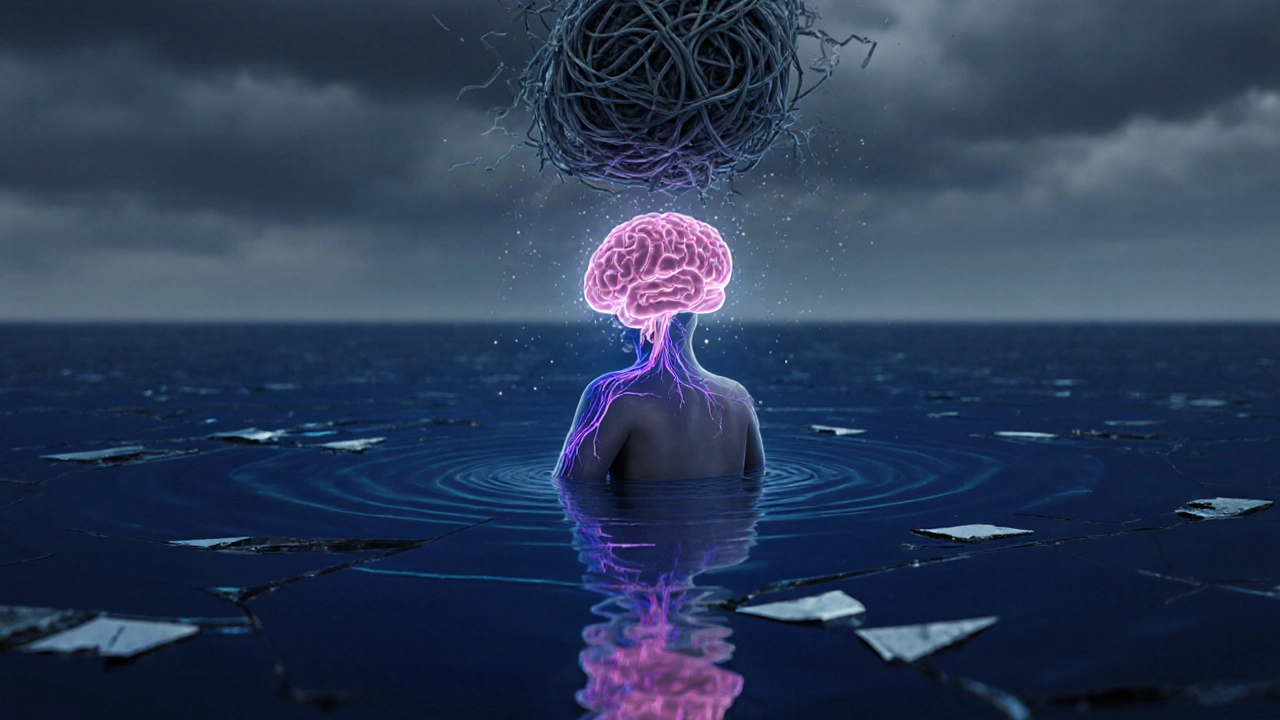Mental Health Symptom Assessment
This assessment helps you recognize symptoms of common mental health conditions. Based on your responses, you'll receive information about which disorders may share similar symptoms. This tool is for informational purposes only and should not be used as a diagnosis or replacement for professional medical advice.
Select symptoms you experience
Quick Takeaways
- The level of psychological pain varies by disorder, personal history, and support system.
- Major depressive disorder, borderline personality disorder, and schizophrenia are repeatedly cited as the toughest to live with.
- Clinicians use rating scales like the Beck Depression Inventory and the Visual Analogue Scale for mental pain.
- Effective coping blends therapy, medication, lifestyle tweaks, and community support.
- A clear treatment plan can reduce the "most painful mental illness" impact dramatically.
When people ask about the Mental illness is a health condition that influences thoughts, emotions, and behavior, the answer isn’t a one‑liner. Pain in the mind can feel like a heavy weight, a relentless pressure, or an unpredictable roller‑coaster. It’s shaped by the disorder’s core symptoms, how long they’ve lasted, and the person’s life context. Below we unpack the conditions that most sufferers describe as the most painful mental illness to endure, explain why the pain runs so deep, and share practical steps to lighten the load.
What Makes Psychological Pain Different from Physical Pain?
Psychological pain activates many of the same brain pathways as physical hurt - the anterior cingulate cortex and insula light up in both scenarios. Yet, mental anguish can be invisible, harder to quantify, and often ignored by society. That invisibility fuels stigma, which in turn magnifies the suffering. Understanding the science behind the pain helps us see why some disorders are repeatedly ranked at the top of “most distressing” lists.
Top Conditions Frequently Called the Most Distressing
Researchers, clinicians, and patient advocacy groups regularly point to a handful of diagnoses when discussing extreme mental anguish. Below are the leading contenders, each introduced with a short microdata definition.
Major depressive disorder is a persistent feeling of sadness, loss of interest, and profound fatigue that lasts at least two weeks. Patients describe an "emotional numbness" that feels like sitting in a cold pool of hopelessness, often accompanied by suicidal thoughts.
Borderline personality disorder is a pattern of unstable relationships, self‑image, and intense emotions, with a fear of abandonment. Emotional swings can erupt within minutes, making daily life feel like walking on a tightrope.
Schizophrenia is a chronic brain disorder marked by hallucinations, delusions, and disorganized thinking. The constant battle with voices or distorted reality creates a unique, crushing form of mental pain.
Post‑traumatic stress disorder (PTSD) is a condition triggered by exposure to a traumatic event, leading to flashbacks, hyper‑arousal, and avoidance. Reliving the trauma over and over can feel like a wound that never heals.
Bipolar disorder is a mood disorder characterized by alternating periods of depression and mania. The swing from depressive lows to manic highs can be exhausting and terrifying.
Obsessive‑compulsive disorder (OCD) is a anxiety condition where unwanted thoughts trigger repetitive behaviors. The mental loop of intrusive images or urges can dominate a person’s day.
Anorexia nervosa is an eating disorder where an intense fear of gaining weight leads to self‑starvation. The constant self‑critique and physical decline generate a blend of psychological and physiological torment.

How Clinicians Measure Mental Suffering
There’s no single “pain meter” for the mind, but mental‑health professionals rely on a mix of self‑report scales and clinical interviews. The most common tools include:
- Beck Depression Inventory (BDI): 21‑item questionnaire that quantifies depressive severity.
- Visual Analogue Scale for Mental Pain (VASM): a 0‑100 slider where patients rate how much mental distress they feel right now.
- Borderline Symptom List (BSL‑23): captures emotional volatility and self‑harm urges.
- Positive and Negative Syndrome Scale (PANSS): evaluates schizophrenia symptoms, including distress caused by hallucinations.
These numbers help clinicians compare “pain” across disorders, track changes over time, and tailor interventions.
Why These Disorders Rank Highest in Pain
Three core factors explain why the conditions above often top the pain rankings:
- Symptom intensity: Hallucinations, intrusive thoughts, or relentless sadness bombard the mind continuously.
- Loss of control: Many patients feel helpless against their own thoughts, which intensifies despair.
- Social isolation: Stigma and misunderstanding push sufferers into loneliness, magnifying the internal sting.
When any of these three aligns, the mental anguish can eclipse even the most severe physical ailments.
Effective Coping Strategies
Even the "most painful" conditions can become manageable with the right toolbox. Below are evidence‑based techniques that many patients find helpful.
- Dialectical Behavior Therapy (DBT): Especially useful for borderline personality disorder; teaches distress tolerance and emotion regulation.
- Cognitive Behavioral Therapy (CBT): Helps reshape negative thought patterns in depression, anxiety, and OCD.
- Medication adherence: Antidepressants, antipsychotics, or mood stabilizers can reduce symptom severity when taken consistently.
- Mindfulness and grounding: Simple practices like 5‑4‑3‑2‑1 sensory checks calm PTSD flashbacks.
- Peer support groups: Hearing stories from others living with the same condition lessens feelings of being "the only one".
- Physical activity: Regular exercise releases endorphins that counteract depressive and anxiety symptoms.
Combining these approaches with professional guidance creates a layered safety net, often turning unbearable pain into a survivable challenge.

Comparison of the Most Distressing Disorders
| Disorder | Core Pain Drivers | Typical Onset Age | Standard Treatment Mix | Average Recovery Timeline |
|---|---|---|---|---|
| Major depressive disorder | Persistent sadness, anhedonia, suicidal ideation | Late teens‑30s | CBT + SSRI/ SNRI | 6‑12 months (varies) |
| Borderline personality disorder | Emotional volatility, fear of abandonment, self‑harm urges | Adolescence‑early 20s | DBT + mood stabilizer (if needed) | Several years; chronic but improvable |
| Schizophrenia | Hallucinations, delusions, social withdrawal | Late teens‑mid‑30s | Antipsychotics + CBT for psychosis | Lifetime management; acute phases 3‑6 months |
| PTSD | Flashbacks, hyper‑vigilance, avoidance | Any age after trauma | Trauma‑focused CBT + EMDR | 1‑2 years (with intensive therapy) |
| Bipolar disorder | Manic highs, depressive lows, impulsivity | Late teens‑20s | Mood stabilizer + psychotherapy | Chronic; mood episodes spaced months‑years apart |
Living with the "Most Painful" Condition: Real‑World Tips
Below are bite‑size actions you can start today, whether you’re the person struggling or a loved one offering support.
- Set a daily check‑in: Write a brief note on mood, sleep, and medication. It creates a pattern for both you and your therapist.
- Identify "early warning" signs: For depression, it might be withdrawing from friends; for schizophrenia, an increase in suspicious thoughts.
- Build a crisis plan: List emergency contacts, safe spaces, and coping techniques to use when pain spikes.
- Limit exposure to triggers: If social media fuels anxiety, set a timer or use a content blocker.
- Celebrate tiny victories: Even a 5‑minute walk counts as progress when pain feels insurmountable.
Consistency beats intensity. Small, repeatable habits gradually erode the wall of mental suffering.
When to Seek Professional Help
If any of these apply, reaching out ASAP is critical:
- Thoughts of self‑harm or suicide.
- Hearing voices that command harmful actions.
- Inability to perform basic daily tasks (eating, bathing).
- Severe mood swings that endanger personal safety.
Emergency services, crisis hotlines, or a trusted mental‑health provider can intervene before the pain leads to irreversible outcomes.
Frequently Asked Questions
Which disorder causes the most constant mental pain?
Most clinicians agree that major depressive disorder and borderline personality disorder produce the most relentless, day‑to‑day emotional ache because the distress persists without clear external triggers.
Can medication fully eliminate the pain?
Medication can calm the neurochemical storm, but lasting relief usually requires therapy, lifestyle changes, and a solid support network. Think of meds as the foundation, not the whole house.
Is there a genetic link to these painful disorders?
Family studies show higher prevalence for depression, bipolar disorder, and schizophrenia, suggesting genetics play a role. However, environment and life events interact heavily, so genetics alone don’t dictate destiny.
How long does therapy usually last?
For acute depressive episodes, 12‑20 CBT sessions are common. Personality‑focused treatments like DBT may run 6‑12 months or longer, depending on progress.
What can families do to support someone with severe mental pain?
Listen without judgment, help maintain treatment routines, and learn about the specific disorder. Educating yourself reduces stigma and creates a safer space for recovery.





